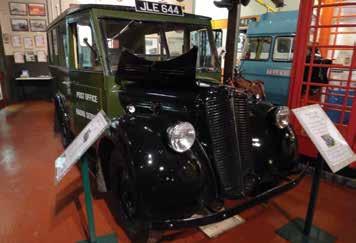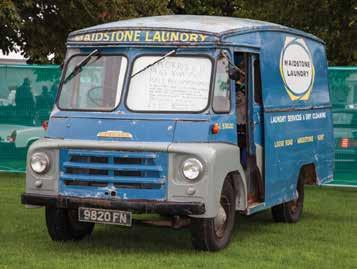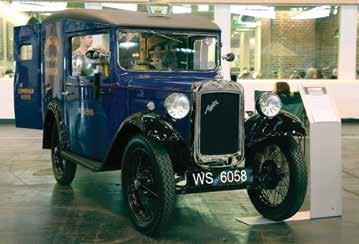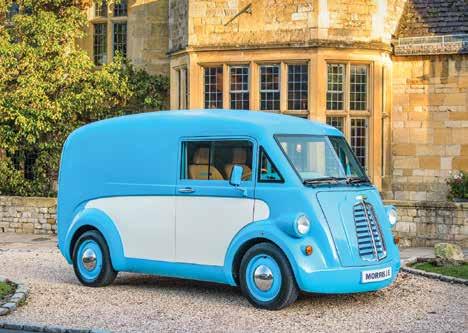
5 minute read
TIMES PAST
Morris Commercials – Driving business right to the end
MORRIS JE-1
when pictures were released of an all-new electric version of the Morris J-Type, the classic van from the 1950s, they sparked renewed interest into the history of Morris Commercials. A recently published book by Veloce Publishers on Morris Cars by Ray Newell, the pictorial history provides a great insight into the broad model line-up produced by the British brand over five decades.
Morris Motors’ initial commercial vehicle was a commercial of its first passenger car, the Oxford, prior to World War I. In 1924, the Cowley based company expanded into heavier commercial units and formed Morris Commercial Cars Ltd., after William Morris acquired the factory of axle manufacturer E.G. Wrigley & Co. Ltd., at Soho, Birmingham. E.G. Wrigley & Co supplied axles and steering sets to W.R.M. Motors Ltd., (the forerunner of Morris Motors Ltd), between 1913 and 1917 for the 10hp, ‘White & Poppe’ engined Morris Oxford.
Between 1924 to 1968, Morris Commercial Cars manufactured 85 different types of vehicles, from light car derived vans to large vans, pick-ups, trucks, buses, ambulances and fire engines. During World War II, Morris was an integral manufacturer of military equipment for the British Army and also built components for Rolls Royce aero engines. Then, in 1948, the aforementioned J-Type, a new forward control 10 cwt van was unveiled at the Commercial Transport Show in London. Designed with a sliding door on both sides, and a 150 cu.ft load volume, the J-Type gained global sales success. It was replaced by the Morris J4 in 1961.
Car-derived-vans emerged from the early 1950s, converted from established models such as the Morris Minor, Morris Oxford and the Mini Minor. When Morris and Austin merged in 1952 to form the British Motor Corporation (BMC), many models shared the same technology, chassis, body shells and drivetrain but with their own branding. Special bespoke versions were produced for major fleet operators such as the Royal Mail and Telephone
service providers. A Sun Tor campervan version of the Morris half-ton van with two-tone paint finish from 1954 is one of the standout photos in Ray Neville’s book. With 21 plants overseas, Morris Commercial was at one stage the leading manufacturer of commercial vehicles in the world, exporting to 25 counties. Through other acquisitions and mergers within the British motor industry, BMC became part of the British Leyland Motor Corporation in 1968. From then on both Morris and Austin commercial vehicles had to carry a BMC badge instead of individual marque names. The main production facility at Adderly Park in Birmingham closed in 1971, marking the end of Morris Commercials. However under British Leyland, the Morris and Austin brands got a stay of execution, albeit under a different guise, with the development of the Austin Morris 7/10 cwt panel van and 10 cwt pick-up. Launched in 1972 and manufacturer up until 1980, over 150,000 units were produced. This model series was replaced by the Morris Ital van and pick-up and became the last such vehicle to carry the Morris name beyond 1985. However, BL was not done with the commercial marketplace. Remember the Austin Metro? Well, there was a Morris Metro Van version. Better MORRIS Commercial 1939 known as the Metro Van, it boasted a 45.7 cu.ft load volume. Powered by 1.0-litre and 1.3-litre A Plus petrol engines, there were two spec levels to choose from. Metro from the time of its introduction in 1982 was Britain’s best-selling small car. Staunch enthusiasts of the Morris name were given an unexpected surprise when SAIC Motor announced plans to create an all-electric commercial based on the original J-Type van. The largest automobile manufacturer in China is to produce the J-Type zero-emission van and it’s no coincidence that the assembly line will be once again be located in Birmingham. Ground hog days coming around again!

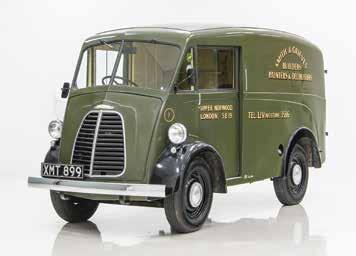
MORRIS J-type
MORRIS COMMERCIALS – hISTORICAL TIME-LINE
Morris Commercial Cars Ltd. registered February 1924, registered office Foundry Lane, Soho, Birmingham. William Morris acquires factory/site from receivers of E. G. Wrigley & Co Ltd., (which had occupied site since 1902).
1924 – 1 ton truck production commences. Within 8 years, 15 different types of vehicles are in production at Foundry Lane, ranging from 10cwts to 50cwts, many of which are powered by the company’s own engines.
1932 - Morris Commercial Cars Ltd. moves to former Wolseley works at Adderley Park. First double-deck bus – the Imperial is produced here. ‘C’ type range of commercial vehicles announced in 1933. Very successful, but by 1937 has become a little dated. Pressed steel bodied advances lead to the Equi-load range going into production.
War years – Adderley Park factory works to support the War effort, producing military vehicles, tanks, gun platforms, and transmission units for torpedoes and anti-submarine weapons. The factory also produces components for Rolls-Royce Merlin and Griffin aero engines.
Post-war – 1949: MCC introduces FV type and J-type van – a type much favoured by the GPO. 1952 - Morris Motors merges with Austin Motor Co. For a short period there is no outward change, but then equi-load range is discontinued, and updated in the form of the LC5 and NV types. LD range of vans and ambulances, using the well-known (ex-Austin) BMC 2.2 litre 4cylinder petrol engine is produced extensively.
1954 – 1963: MCC-designed OE diesel engines are made at Adderley Park and successfully power many Austin/Morris trucks and Nuffield tractors.
1968 – Distinction between Morris and Austin commercial vehicles ceases, production now being labelled BMC, thereby ending the era of Morris Commercial vehicles.
1974 – Adderley Park factory closed, and remnant production facilities moved to former Tractors & Transmissions (Wolseley works) at Drews Lane. This site eventually becomes LDV vans. (Coincidently, the LDV Maxus brand is also owned by SAIC Motor, which is about to produce the new JE-Type van).
1963 – 1986: Larger truck and diesel engine production is re-located to recently-opened plant, near Bathgate, Scotland.Morris Y Type 10 CWT Van C 1947
MORRIS 2015 Automart
